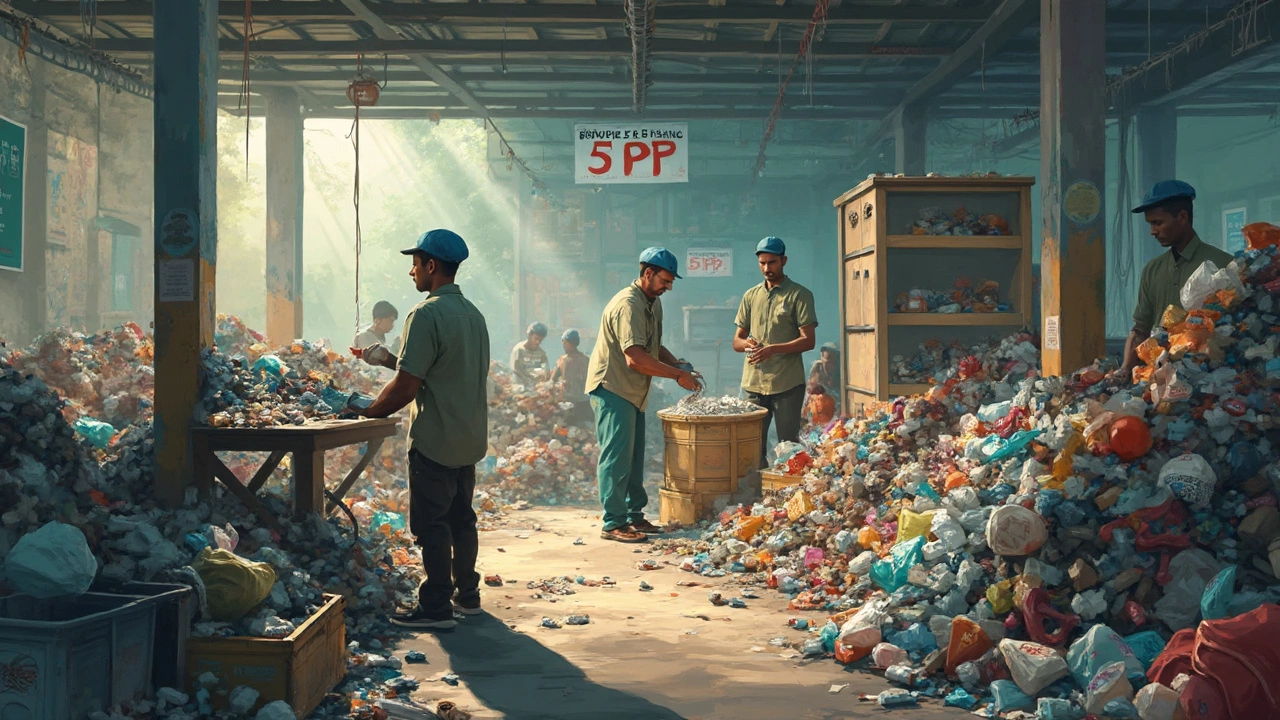If you've ever flipped over a plastic container and seen the tiny triangle with a number inside, you might have wondered what it all means. When you spot a '5' with 'PP' underneath it, you're looking at polypropylene, one of the most versatile plastics out there. It's everywhere, and knowing a bit about it can help make the world feel a tad less confusing.
Now, what's so special about this number? The '5' isn’t just a random assignment—it's part of a set of symbols called Resin Identification Codes. These help you figure out the type of plastic you're dealing with, which is super important for recycling. The more you know, the better choices you can make at home or while shopping.
You'll find 5 PP in everyday stuff like yogurt containers, bottle caps, and even some of your favorite kitchen tools. It's chosen for these products because it's durable and has a high melting point. That's mostly why it works well for items exposed to heat, like dishwasher-safe containers.
But it's not just about where it ends up in your house. Understanding how to properly recycle 5 PP can make a difference for the environment. Make sure to check your local recycling rules, as they can vary. Some areas are awesome at recycling PP, while others might not accept it. So, don’t just toss it without checking. We owe it to ourselves and the planet to be a bit more mindful.
- The Basics of Plastic Numbers
- Characteristics of 5 PP Plastic
- Common Uses of Polypropylene
- Recycling and Environmental Impact
The Basics of Plastic Numbers
Ever notice those little numbers inside triangles on your plastic stuff? They’re not just decoration! These are Resin Identification Codes, and they help you figure out what type of plastic you're holding. Important to know, especially if you're trying to be an environmentally savvy person.
The whole system came about in the late '80s, thanks to the Society of the Plastics Industry (now the Plastics Industry Association). They wanted a way to make recycling easier, and presto, these numbers were born. There are seven categories, each representing a different type of plastic. Whether you’re holding a soda bottle or a butter tub, knowing that number can tell you a lot about how to dispose of it.
Here's a quick rundown:
- 1: PET or PETE – Think soda bottles and peanut butter jars. It's widely recycled.
- 2: HDPE – Used for milk jugs and shampoo bottles. This one’s a recycling champ in many places.
- 3: PVC – Used for pipes and some clear food packaging. Not so easy to recycle.
- 4: LDPE – A bit of a recycling challenge, you’ll find this in grocery bags and some bottle caps.
- 5: PP (Polypropylene) – This is your go-to for yogurt cups and straws, highly valuable in the recycling world.
- 6: PS – Found in disposable plates and cups; tricky to recycle.
- 7: Other – All the oddballs that don't fit in elsewhere, like polycarbonate. These can be tough nuts to crack environmentally.
So, knowing these numbers isn't just for plastic junkies. It's crucial for everyone who wants to handle their waste responsibly. Recognizing your 5 PP helps not only to pick the right container but also to ensure it’s recycled properly, minimizing environmental impact. Don’t just wing it—get familiar with these numbers, and you’ll be amazed at the positive change you can make.
In case you're curious, here's a quick data point for perspective:
| Code | Plastic Type | Recycling Rate (approx.) |
|---|---|---|
| 1 | PET | 29.1% |
| 2 | HDPE | 30.9% |
| 5 | PP | 9.9% |
These rates serve as a wake-up call to be more proactive about recycling, especially for those lagging numbers. It's about doing our bit to keep those plastics out of the landfill.
Characteristics of 5 PP Plastic
Let's break down what makes 5 PP plastic special. First off, it's known for being super tough yet lightweight. This makes it a no-brainer for things that need to handle a bit of wear and tear, like reusable containers you toss into your bag each day.
An awesome thing about polypropylene is its high resistance to heat. You won't see it melting easily, which is why it's often used in items you can safely pop into the dishwasher or microwave. Now, that's convenience without worry!
PP also plays nice with other chemicals. So, it's not going to react weirdly if your shampoo leaks a little in your luggage. Plus, it doesn’t absorb water, making it a great choice for packaging products that might get wet.
Here’s a cool detail: PP is a low-density plastic. Basically, it means you get more strength from less weight. Plus, it's pretty versatile when it comes to flexibility. It can be made flimsy like in throw-away utensils or solid enough to make battery cases.
Let's look at a quick stat table that shows some key data:
| Property | Value |
|---|---|
| Density | 0.90-0.92 g/cm³ |
| Melting Point | 160-170°C |
| Tensile Strength | 30-40 MPa |
Thanks to these traits, 5 PP plastic is a staple in so many products, and it's easy to see why. Whether you're picking a new water bottle or sorting your recycling, having some insight into polypropylene's characteristics definitely can't hurt.

Common Uses of Polypropylene
Polypropylene, or 5 PP plastic, is basically like the Swiss army knife of the plastic world. You'll find it in a bunch of things you use every day because of its durability and versatility.
First off, let's talk about its role in food packaging. Those see-through, sturdy containers that stack nicely in your fridge? Yup, that's usually polypropylene. It's resistant to heat, so it's perfect for microwaveable containers and lids. Plus, it's not reactive, keeping your food safe from unwanted chemicals.
Fashion-wise, 5 PP makes a guest appearance in the clothing industry. Ever heard of sportswear fibers? Well, polypropylene is the secret ingredient in moisture-wicking and quick-drying fabrics. It keeps you comfy when you're on the move by helping to manage sweat effectively.
Moving to household items, you might recognize it in your dishwasher-safe utensils or the sturdy tops of detergent bottles. It's tough enough to handle wear and tear, so it's fantastic for reusable goods.
Even in the medical field, polypropylene plays its part. Medical devices and lab containers often use it because it's easy to sterilize and doesn't absorb moisture. It's these properties that make it reliable and hygienic for medical settings.
Finally, let's not forget automotive parts. Car batteries, bumpers, and even some interior details use this polypropylene. Its toughness and resistance to impacts and chemicals make it ideal for vehicles.
With loads of applications, it's pretty clear why polypropylene is a top choice in the plastic family. Whether it's in your kitchen drawer or keeping you dry during a workout, 5 PP plastic is practically everywhere, making life a bit easier.
Recycling and Environmental Impact
When it comes to recycling, not all plastics are created equal, and 5 PP plastic (polypropylene) is a perfect example. It's recyclable, but the process can differ depending on where you live. First things first, always give your local recycling guidelines a quick check to ensure they accept polypropylene. Some places are on top of their game and encourage recycling this versatile material, while others might still be catching up.
Polypropylene boasts some real perks in the recycling field. It's strong and durable, meaning it can be recycled into items that have a lot of life left in them. Think about new playground equipment, containers, or automotive parts. When you recycle it, you’re giving it a second go-round rather than adding to the landfill.
But here's the catch: the recycling rate for polypropylene isn't as high as we might like. It's believed that less than 1% of PP is recycled globally. This low rate makes it crucial for us to clean and sort our plastics at home to make recycling more efficient. Even small efforts make a big difference.
Environmental impact is always something to keep in mind. While it's great that polypropylene is tough and does not degrade easily, it also means it's sticking around a long time if it's tossed in the wrong place—like nature! That's why it's important to recycle it properly or find ways to reuse it.
All these efforts can add up to a significant reduction in our environmental footprint. So, next time you see that trusty 5 on your plastic, pause, and think of the journey it can take—from a yogurt cup to something new and useful!
